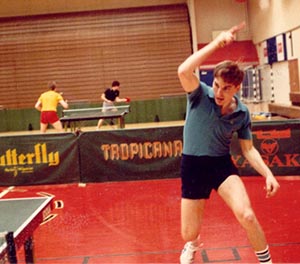Timmy Boggan’s Coming to Town! [Sung to the tune of “Santa Claus is Coming to Town”]
He’ll be here at 10AM, and when he says 10AM, he means exactly 10AM. Knowing Tim, at 10:01AM we’ll be working on Volume 20 (!) of his History of U.S. Table Tennis. As noted in previous blogs, I do the page layouts and photo work. Mal Anderson has already scanned the photos and sent them to me. We’ll be working from 7AM to 5PM for the next 10-12 days (working around my coaching schedule on weekends), with Tim looking over my shoulder and periodically saying things like, “That goes there, you fool!”
Tim keeps strange hours, going to bed every night around 7PM and getting up around 3AM. So he’ll be puttering around my house each morning, impatiently waiting for me so we can get started at 7AM. But he’s a USATT Hall of Famer and the USATT Historian, so who are we to judge?
This is a tricky time for me—or should I say exhausting? After I finish my work with Tim, I’ll be leaving nearly every day to the club for a few hours of coaching. And then, after getting home perhaps at 8 or 9PM, because I won’t have much time in the morning (those 7AM starting times), I’ll be up late getting the blog done mostly in advance, as well as other USATT and MDTTC stuff that can’t be put off. Basically, for the next 10-12 days I’ll be living off Mountain Dew.
In honor of Tim, let’s all sing together - and if you video yourself singing this and put it online, and either put it in the comments below or email the link to me, you'll be in my blog tomorrow!
You better play smart,
Don’t put the ball high,
Better have heart,
I'm telling you why,
Timmy Boggan’s coming to town!
He's making a list,
Of playing advice,
Gonna find out who's games aren’t nice,
Timmy Boggan’s coming to town!


 Photo by Donna Sakai
Photo by Donna Sakai


